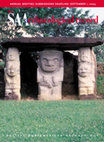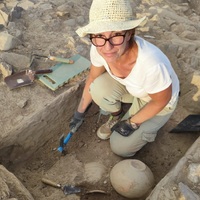Books by Nicholas Tripcevich
In this book leading experts uncover and discuss archaeological topics and themes surrounding the... more In this book leading experts uncover and discuss archaeological topics and themes surrounding the long-term trajectory of camelid (llama and alpaca) pastoralism in the Andean highlands of South America. The chapters open up these studies to a wider world by exploring the themes of intensification of herding over time, animal-human relationships, and social transformations, as well as navigating four areas of recent research: the origins of domesticated camelids, variation in the development of pastoralist traditions, ritual and animal sacrifice, and social interaction through caravans. Andeanists and pastoral scholars alike will find this comprehensive work an invaluable contribution to their library and studies.
From stone for building to metal ores for ceremonial display, extracting mineral resources from t... more From stone for building to metal ores for ceremonial display, extracting mineral resources from the earth played a central role in ancient Andean civilizations. Despite this, the sites that supported these activities have rarely been a source of interest to archaeologists, and comparative analysis between mines and quarries and their features has been exceedingly rare.

Dissertation
Regional studies of obsidian artifacts in the south-central Andes have shown that over 90% of the... more Regional studies of obsidian artifacts in the south-central Andes have shown that over 90% of the analyzed artifacts from the Lake Titicaca Basin belong to a single geochemical obsidian type. A decade ago researchers identified the geological origin of this obsidian type as the Chivay / Cotallalli source, located 180km west of Lake Titicaca above the Colca valley in Arequipa at 71.5355° S, 15.6423° W (WGS84), and at 4972 meters above sea level. This research project focused on the obsidian source and adjacent lands within one day’s travel from the source. The project included a 33 km2 survey, 8 test units, and in-depth lithic attribute analysis. Mobile GIS (Arcpad) was used extensively during survey. A substantial quarry pit and an obsidian workshop were examined closely, as were consumption sites in nearby areas. The results of this study found that the earliest diagnostic materials at the source date to the Middle Archaic (8000 – 6000 BCE) and that intensification of obsidian production occurred earlier than previously recognized, at circa 3300 BCE Increased obsidian production appears to have been focused on the acquisition of large (> 20cm) and homogeneous obsidian nodules, although the formal tools produced with obsidian were predominantly small projectile points. It is argued that the acquisition of large, homogenous nodules was prioritized because the production potential of large nodules was highest, and because obsidian was associated with competitive display among early aggrandizers. The timing and economic associations of obsidian production and circulation suggest that the possession of large obsidian pieces in the Titicaca Basin was a demonstration of social connections to distant resources, and to regional trade networks that emerged with regularized camelid caravan transport networks. Obsidian artifacts were not inherently “prestige goods”, rather it is suggested here that obsidian was the least perishable of a number of cultural goods distributed by an expanding network of caravans that linked communities in the region. The acquisition and consumption of these cultural goods was a demonstration of economic connections and cultural influence during the dynamic period of incipient social inequality between the Terminal Archaic (3300–2000 BCE) through the Middle Formative (1300–500 BCE).
This UCSB doctoral dissertation is archived in an open access repository at http://escholarship.org/uc/item/3m37097d
Book Chapters by Nicholas Tripcevich
Archaeology of Andean Pastoralism, 2016
The Archaeology of Andean Pastoralism, 2016

Mining and Quarrying in the Ancient Andes, 2013
We consider how and why archaeologists have studied the vestiges of mining and quarrying, and to ... more We consider how and why archaeologists have studied the vestiges of mining and quarrying, and to consider a specific Andean context: the extraction of Quispisisa-type obsidian from the Jichja Parco obsidian quarries over a period of 10,000 years of Central Andean prehistory. Preliminary research at the source ( Contreras et al. in press; Tripcevich and Contreras 2011 ) has documented large-scale extraction of obsidian, while regional consumption patterns (Burger and Glascock 2002 ) demonstrate that the material was used and widely distributed not long after humans arrived in the Central Andes. We use the example of ongoing research at the Quispisisa source to examine what study of mining and quarrying in the Prehispanic Andes can contribute to perspectives on the Andean past. More generally, we reflect on the actual questions that archaeologists hope to address by examining mines and quarries, and consider how we can approach mining and quarrying evidence in such a way as to be able to answer such questions.
This study connects household-level long-distance exchange of ordinary goods with research into t... more This study connects household-level long-distance exchange of ordinary goods with research into the emergence of complex societies at high altitudes in the south-central Andes.
Papers by Nicholas Tripcevich
Regional studies of obsidian artifacts in the south-central Andes have shown that over 90% of the... more Regional studies of obsidian artifacts in the south-central Andes have shown that over 90% of the analyzed artifacts from the Lake Titicaca Basin belong to a single geochemical obsidian type. A decade ago researchers identified the geological origin of this obsidian type as ...

The Saa Archaeological Record, 2004
The biggest rewrite of Utah's liquor laws in more than a decade went into effect on May 5, 2003. ... more The biggest rewrite of Utah's liquor laws in more than a decade went into effect on May 5, 2003. New laws increased the size of legal drinks and simplified the process of getting into private clubs-Utah's equivalent to bars. As Olympic partygoers found, it is just as easy to get a drink in Salt Lake as it is to order a meal. And visitors rarely notice a difference between Salt Lake and other major American cities. "Some people are surprised at how easy it is to have a good time here," said Deno Dakis, general manager of Port O' Call Social Club in downtown Salt Lake, and nine-year veteran of Salt Lake's club scene. "People come expecting a buttoned-down, conservative culture and find a town ready to party, with cool clubs, great restaurants, and fun bars." Restaurants in Salt Lake serve alcohol with the purchase of food, just like restaurants in New York, Los Angeles, Chicago, Las Vegas, and New Orleans. Private clubs are Utah's equivalent to bars. While the term 'private club' may sound exclusive, they are open to everyone. Visitors purchase two-week memberships, similar to a cover charge in other cities. The memberships cost $4 and allow sponsorship of other guests. "The term 'private club' in any other city is associated with a snobby sort of experience," says Michael LePrey, general manager of Green Street Social Club in Historic Trolley Square. "In Utah, a private club is the same thing as a bar anywhere outside of the state." In the private club business for 23 years, LePrey said there may be unseen advantages to the system. "We work very hard to make sure out-of-town guests feel welcome, partially to overcome any preconceived ideas about what a private club is," he said. "For the most part, private clubs are more personable, friendly, and accommodating than bars in other states because we want to compensate for the label." Private clubs have full bars and some allow smoking. Mixed drinks, wine, and beer are also served in restaurants and hotels with the purchase of food. Grocery and convenience stores sell beer. Sixteen conveniently located state liquor stores in the Salt Lake area sell wine, spirits, and beer. There are more than 1,000 alcohol-serving restaurants, clubs, pubs, and stores in the greater Salt Lake area. In 2001, the people of Utah consumed 4 million gallons of wine and liquor, making the state far from dry. Utah operates one of the most comprehensive wine stores in the United States. Locat
Abstract This paper explores the potential for using viewshed analysis methods with settlement su... more Abstract This paper explores the potential for using viewshed analysis methods with settlement survey data in a grassland environment. Innovations in geographical positioning and spatial analysis technology permits archaeological surveyors to rapidly gather greater quantities and better quality spatial data than was formerly possible. A variety of statistical analyses and agent-based models are made possible with the more exhaustive and statistically robust data. Site location criteria are considered with respect to both the ...
Abstract This talk is about a study of transportation in highland Peru where we travelled with a ... more Abstract This talk is about a study of transportation in highland Peru where we travelled with a traditional llama caravan for fourteen days. Our focus was on studying transport speed and how trails and obstacles were negotiated, attention to changes in trail steepness and the footing, and other trail characteristics. The ability to transport goods is a key attribute of mobile pastoralism in both contemporary settings and in the past. In mountainous environments, groups of cargo‐bearing animals being led along trail systems was often ...

Based on a Society for American Archaeology symposium, Tripcevich and Vaughn compiled this v... more Based on a Society for American Archaeology symposium, Tripcevich and Vaughn compiled this volume for a comparative analysis of mining and quarrying, a rare undertaking in Andean studies. These papers are a welcome addition to the growing interest among Andeanists in contextualizing the organization and technology of production to better understand lithic, metal, and other finished products that have traditionally received the greatest attention in the literature. The editors propose to demonstrate that mining and quarrying are embedded in Andean life and reach beyond economic purposes, and to highlight the following themes across time and space: technological choices, differentiation of extraction and processing loci, symbolism related to quarrying and mining, and classification of state versus local control of production. As quarries and mines with preserved direct evidence for extraction are relatively sparse in the Andes, the volume’s diversity of geographic and temporal cases, ranging from the Archaic to Inca periods and from central Ecuador to central Chile, is an accomplishment in itself. Andeanists and those interested in the extraction and processing of solid materials from the earth in any world region will find much of value in this volume. It succeeds especially in adding to the growing database on primary contexts and in initiating a multidisciplinary and cross-cultural dialogue on these activities in the ancient record. There are sixteen chapters in four parts: Part I provides a discussion of theoretical and methodological underpinnings; Part II covers pigment, clay, salt, and stone; Part III addresses metals; and Part IV gives a broader overview of the importance of reconstructing mining and quarrying. Although six chapters are devoted principally to metallurgy, lithic specialists will still find useful data. Many studies identified simultaneous quarrying at mines and analyzed the stone tools used for extraction and secondary processing of minerals, in addition to an overall emphasis on the operational sequence and the sacred and political implications of mining and quarrying. In an introduction, Vaughn and Tripcevich (Chap. ) outline previous Andean studies as they relate to other world regions. Their efforts are urgent and vital, as nearly all craft goods in the Andes involved raw materials from quarries and mines, yet the region has received much less attention compared to Europe and the Mediterranean. The chapter introduces the volume’s central themes: () the technological considerations of choosing raw materials and adapting to their properties, () the local and regional scales of extraction and processing, () the role of shrines and offerings at or near extraction sites and the constitution of sacred geographies around mining, and () the economic and political elements of mining and quarrying. Focusing on chipped stone, Tripcevich and Contreras (Chap. ) look at interquarry variability over a ,-year period at Jichja Parco (the well-known Quispisisa source) and outline the material expectations for the organization and significance of quarrying vis-à-vis obsidian extraction. The paper serves primarily as a call to action as they have not collected the necessary data yet for fully executing this plan. They aim to eventually reconstruct whether quarries form slowly over time or quickly through intensified exploitation in order to understand processes of continuity, standardization, controlled access, labor coordination, and the presence of local or regional authority. Their description of the distribution of quarry pits at Jichja Parco complements the current wave of research in geochemical sourcing that dominates obsidian consumption studies. Two chapters on quarrying architectural stone seek cultural significance in the selection of dimension stone used to build ritually and politically important structures in developing states. Ogburn’s study (Chap. ) of the “high status,
This paper will describe archaeological research recently conducted in southern Peru where archae... more This paper will describe archaeological research recently conducted in southern Peru where archaeological features were recorded entirely within a mobile Geographical Information System (or GIS). I will present an overview of the technology, and then briefly demonstrate our implementation of the system that was used while camping at high altitude at an obsidian source, and then I'll discuss the benefits and drawbacks of mobile GIS. Ultimately we must ask if it will contribute to better archaeology, or does mobile GIS merely add finer spatial resolution and more delicate technology to existing field methods?
A Social Orientation to Ceramic Raw Materials in the Lake Titicaca Basin?........................... more A Social Orientation to Ceramic Raw Materials in the Lake Titicaca Basin?....................................................................... Material Constraints and Technological Choice................................... Social and Technical Boundaries.......................................................... Raw Materials on a Dynamic Landscape.............................................. Conclusions............................................................................................... References.................................................................................................

North American Archaeologist, 2017
In America’s Far West, chipped stone crescents dating between approximately 12,000 to 8000 cal BP... more In America’s Far West, chipped stone crescents dating between approximately 12,000 to 8000 cal BP are often found associated with Western Stemmed Tradition points. Crescent function is debated, but scholars have suggested that they are closely associated with wetland habitats, an association that has never been systematically investigated. Using a geographic information system-based Euclidean distance analysis, we compared a sample of 100 geolocated crescent-bearing sites in Washington, Oregon, Idaho, Nevada, Utah, and California with reconstructed paleoshorelines. We confirmed a strong association of crescents with wetlands—94 of the 100 sites and approximately 99% of crescents themselves were located within 10 km of reconstructed paleoshorelines. Our results provide quantitative and region-wide support for a strong association of crescents with terminal Pleistocene and early Holocene wetland habitats. The diversity of aquatic habitats crescents are associated with, along with their morphology, suggests an association with faunal rather than plant resources, possibly birds of the Pacific Flyway.










Uploads
Books by Nicholas Tripcevich
This UCSB doctoral dissertation is archived in an open access repository at http://escholarship.org/uc/item/3m37097d
Book Chapters by Nicholas Tripcevich
Papers by Nicholas Tripcevich
This UCSB doctoral dissertation is archived in an open access repository at http://escholarship.org/uc/item/3m37097d
Includes Supplementary Information file containing Shapefiles of GPS tracks, traced hydrography, and more.
Available at https://works.bepress.com/tripcevich/14/
https://bcourses.berkeley.edu/courses/1289761